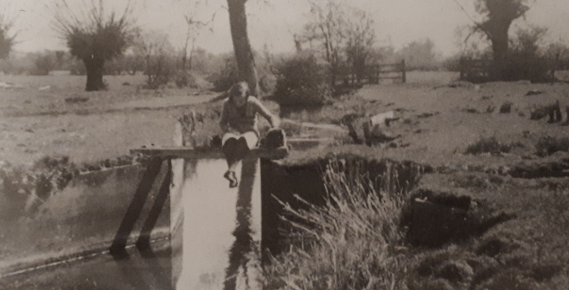
The photograph above, taken in May 1941, shows meadows near Bemerton, Wiltshire (UK), with a girl named Alison sitting on a plank bridge across a stream. Several features would immediately catch the eye of a landscape historian working in the empirical or materialist tradition inspired by W. G. Hoskins’s celebrated 1954 study, The Making of the English Landscape. The stumpy trees in the background on the left, for example, are pollarded willows. Pollarding was an ancient practice whereby trees were pruned back to approximately head height. It was intended to promote rapid growth of shoots and small branches that could then be harvested for use in a range of rural crafts and trades. Pollarding typically produced lower yields and required greater labour inputs than the alternative practice of coppicing, whereby growth was cut back to stump level, but coppicing was only feasible where livestock could be excluded. Hence it can be inferred that these meadows were regularly grazed by livestock – perhaps indeed the white objects between the two trees are cattle lying on the ground? A landscape historian working in the Hoskins tradition might also wonder whether at this date, still more than twenty years before the Swedish engineer Sten Gustav Thulin so fatally invented the plastic carrier bag, the willow pollards were being harvested for withies to make baskets, once a prominent rural industry in some of the river valleys of lowland southern England.
The other feature that would probably catch this landscape historian’s eye is what appears to be a ditch or side channel branching off to the right from the stream, turning through a right angle and leading towards the gap in the fence in the background. This side channel, which itself has subsidiary arms extending perpendicularly to the right, indicates that the meadows before us are managed water meadows. The ‘floating’ of water meadows was one of the defining innovations of the Agricultural Revolution, dating back to the seventeenth century. A grid of irrigation channels was dug and sluices installed to allow a controlled flow of water across the grass. This warmed the soil, deposited nutrients and prevented drought, resulting in a longer growing season and heavier hay crops. However, the system was labour intensive and became less necessary with the advent of artificial fertilisers and imported cattle feeds such as oilcakes; it is unclear whether, in 1941, these meadows were still being floated.
A different landscape historian, inspired perhaps by Denis Cosgrove, John Barrell or one of the other pioneers of the cultural history of landscape, would be more interested in the photograph as a representation. The peaceful, sunlit meadows, apparently innocent of all necessity for labour, accord paradigmatically with the tropes of the pastoral tradition, a literary genre that can be traced at least as far back as the ancient Greek poet Hesiod, an approximate contemporary of Homer. More specifically, the photograph could be adduced as evidence in favour of Alun Howkins’s thesis that bucolic ‘South Country’ landscapes increasingly dominated representations of rural England in the late nineteenth century and the first half of the twentieth. Howkins argued that such representations systematically denied the poverty, unemployment, inadequate housing and social conflict prevalent in rural England during these years. Others, notably Angus Calder, have drawn attention to the ways the nexus between landscape and national identity was mobilized in support of the war effort during WW2, and might take an interest in the date of the photo. In May 1941 the Blitz was still in progress. Was the photograph intended, perhaps, to provide reassurance that far away from the bombing, ‘deep England’ remained inviolate, and that no sacrifice could be too great to ensure its survival?
The material and cultural approaches to landscape history have each generated an extensive, immensely rewarding and, as studies such as Paul Readman’s scintillating Storied Ground: Landscape and the Shaping of English National Identity (CUP, 2018) demonstrate, still developing scholarly literature. Yet when we look at the photograph above through either of these prisms, we are liable to lose sight of what seems to me the most interesting thing in it – Alison herself. What we have before us bears witness not only to material production processes and to cultural ‘ways of seeing’ but to lived experience. What was Alison thinking and feeling as she sat on the plank? Why had she chosen to sit there? How did her surroundings influence her – did she take pleasure in the sparkling water beneath her feet and the sun warming her back? Did she feel secure from adult demands and peer pressures out there in the meadows? Did it matter to her that she was encompassed by green fields and trees, or would she have been just as content sitting in a paved back yard, were she assured of equal privacy? What, in a larger sense, was the role of landscape in her life?
We cannot help being affected by our environment, and we are so in a multitude of ways, mostly unconscious, and even when conscious, rarely articulated, let alone recorded. The historical experience of landscape is therefore exceptionally elusive. Retrieving it – putting Alison back in the picture, so to speak – is the challenge I set myself when I began the research that led, after nearly 20 years, to Lifescapes: The Experience of Landscape in Britain, 1870-1960 (CUP, 2023). It has been a fascinating and rewarding quest and I have enjoyed it more than anything else I have ever worked on. I hope something of that will come through to readers too.
If you would like to find out more about Alison, you may also like to read her sister Jane Holmes’s abridged diary, published by Hobnob Press as Foot Loose in South Wiltshire (2007), from which the photograph is taken with permission, and my article ‘Far away and close to home: Children’s toponyms and imagined geographies, c. 1870–c. 1950’, Journal of Historical Geography 69 (2020), pp. 68-79.
Latest Comments
Have your say!